A DAY in the LIFE: Trig Lane, 1974
Gustav Milne
Leaving Home
Gustav got up, got out of bed and stretched. Since the head of the bed butted against the low kitchen cabinet, it was not a long walk to the kitchen sink to clean teeth, or to the outside loo.
There was no bathroom in this cramped and damp Victorian basement: all the tenants on each floor had to use the public bathhouse down the Cally, the Caledonian Road. It would be another year before a letter from the council was pushed through the door informing the occupants that the property had been declared “unfit for human habitation” and all would therefore be rehoused. That would take another two years of inhuman life, but hey, the rent was very cheap: that was regularly collected on Saturday mornings by the unsmiling landlord who owned half of Islington. He never had to advertise for tenants though: the current lot all knew people, including archaeologists, who were desperate enough for such low rent unfurnished rooms. Once the cats had breakfasted, Gustav set off for work. Down Offord Road, past the hoarding around the still undeveloped bomb site, and off along the Cally. He walked briskly in the opposite direction from the local landmark that was Pentonville Prison. He passed shops, Scotts Electric Bakery, three pubs, the local launderette, a Cypriot corner shop and the newsagent where he had once naively asked for a copy of the Guardian (“No call for that round here son”). Halfway down the street, he crossed to the other side where there was another kebab shop, and rang the bell next door. Punctual as ever, Chrissie appeared from her rooms behind the café, a welcome toasted breakfast in hand, ready for the walk to the City. They never bothered with buses: it was cheaper to walk, and they knew exactly how long it would take, so would never be late.
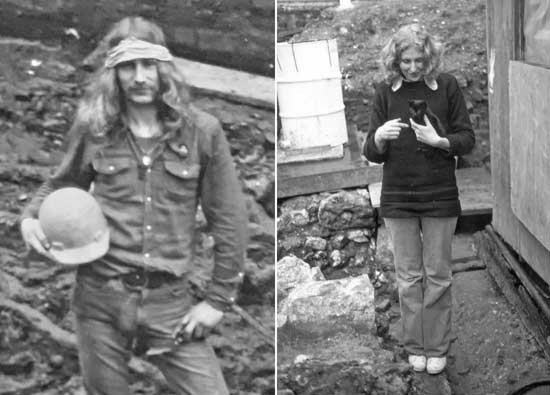 1970s Archaeological Fashion: Gustav and Chrissie with obligatory plimsolls and stray cat
1970s Archaeological Fashion: Gustav and Chrissie with obligatory plimsolls and stray cat
The daily journey took them through Islington, not yet fully gentrified, past estates built since the war and up towards the Angel. They then branched off down Amwell Street or St John’s Street, heading downhill towards the City. In front of them they saw the great profile of St Paul’s, but as they descended, so the dome began to sink below the skyline. Cutting through the quaint back streets of Clerkenwell they reached Smithfield Market. The ornate glass and cast iron roof of the central avenue protected the early morning army of bloodstained porters, working through the high summer stench of dead meat, this was enough to turn you vegan, if such a popular choice had existed in the early 70s. Moving briskly on, past Barts the Great and Barts the Hospital, they reached St Paul’s itself, marking their arrival in the centre of the City by crossing the steps in front of the great West Door. Then down over the multi-lane highway of Upper Thames Street and onto the Trig Lane excavations, their workplace for two and a half years.
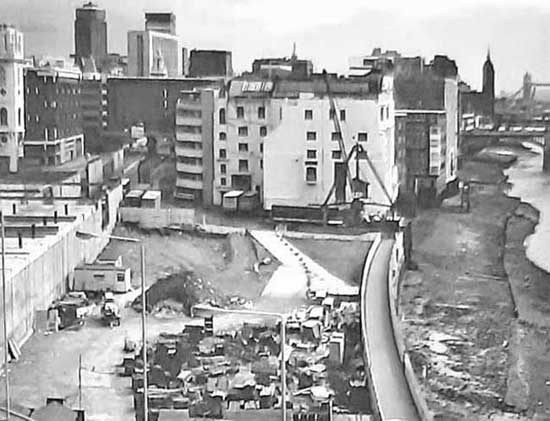 Site of the Trig Lane excavations in the 1970's looking east.
Site of the Trig Lane excavations in the 1970's looking east.
There’s A Place
The site’s northern side, was protected from the roar of the City by the tall concrete walls of a half-completed underpass reflecting light onto the site. To the west towards Blackfriars Bridge, with the quirky exception of the warehouse that became the Mermaid Theatre, was the vast urban expanse cleared of Blitzed buildings as part of the North Bank Improvement Scheme: the grim grey fortress called Baynard House would rise up here, and somewhat later the slightly more cheerful redbrick buildings of the City of London Boys School. To the east, back in the 1970s, were the elegant Sunlight Wharf office and warehouse buildings (c.1906), which survived the Blitz (but not the demands of redevelopment in the 1980s). The complex was part of the last working wharf in this part of the City, with its own 10-ton Butters crane on the quayside, lifting cargoes to and from the barges berthed on the foreshore below. The company also generously provided toilet and washing facilities for the women working on the excavation.
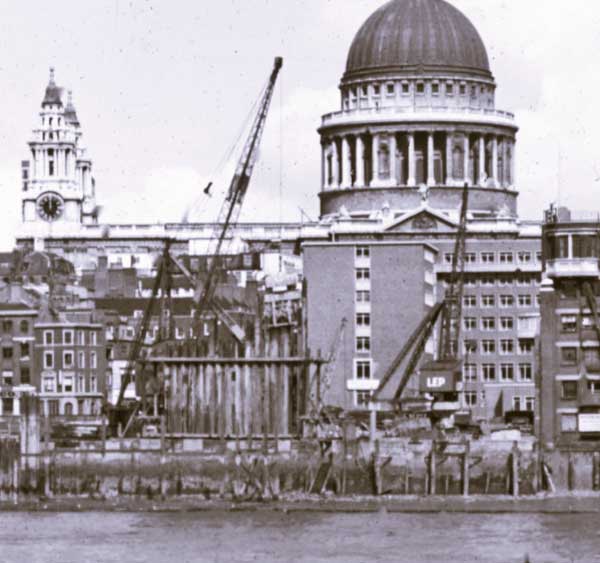 Trig Lane waterfront, 1971: steel shuttering for the Riverside Walkway is being hoisted into placeAnd south of the excavation was the site’s crowning glory, the sparkling Thames itself. Here she ran between two unmistakable landmarks. On the opposite work-a-day Southwark shore stood the Bankside power station, completed in 1960 It was the largest oil-fired generating station in England, its tall chimney pumping out ominous grey clouds throughout the 70s. In marked social and architectural contrast on the City side, the pompously-splendid St Pauls dominated the landscape.
Trig Lane waterfront, 1971: steel shuttering for the Riverside Walkway is being hoisted into placeAnd south of the excavation was the site’s crowning glory, the sparkling Thames itself. Here she ran between two unmistakable landmarks. On the opposite work-a-day Southwark shore stood the Bankside power station, completed in 1960 It was the largest oil-fired generating station in England, its tall chimney pumping out ominous grey clouds throughout the 70s. In marked social and architectural contrast on the City side, the pompously-splendid St Pauls dominated the landscape.
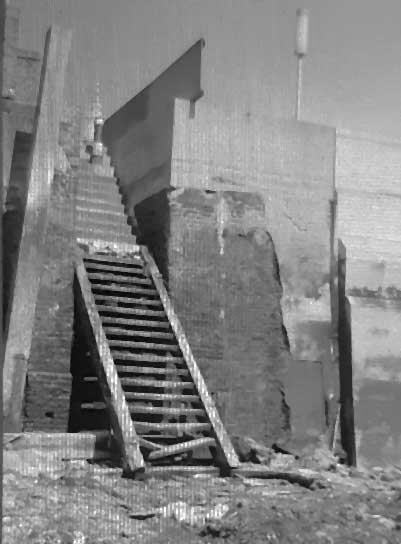 Trig Stairs, slightly worse for wear in the 1970’sAll that protected our site from the river was the newly-constructed concrete walkway, the initial location for the rustic wooden shed serving as a site hut-cum-finds store for the archaeological team. But that riverwall also incorporated a dilapidated wooden stair running down to the foreshore, the last representative of the long lost Trig Lane, a street that could trace its ancestry back to a Plantagenet past. The diggers could therefore walk, picnic or mudlark on the foreshore in their lunch hours if, of course, the tide was out. All in all, an Eden for urban archaeologists.
Trig Stairs, slightly worse for wear in the 1970’sAll that protected our site from the river was the newly-constructed concrete walkway, the initial location for the rustic wooden shed serving as a site hut-cum-finds store for the archaeological team. But that riverwall also incorporated a dilapidated wooden stair running down to the foreshore, the last representative of the long lost Trig Lane, a street that could trace its ancestry back to a Plantagenet past. The diggers could therefore walk, picnic or mudlark on the foreshore in their lunch hours if, of course, the tide was out. All in all, an Eden for urban archaeologists.
As The Day Begins
Just a step away from the traffic and bustle of city life, Trig Lane was usually an oasis of tranquility, but first the noisy but essential pump had to do its magic. Once suitably topped up with a bucket of diesel, it then required a vigorous turn of the starting handle which it acknowledged with an introductory burst of black smoke. Part of the site was flooded every high tide due to a broken culvert: there were occasionally even small fish trapped in the sump, which were duly rescued and returned to the river. Thereafter the only noises on site were of the scraping of trowels, wielding of mattocks and shovelling off shovelling boards, once the spoil had been briefly sorted for finds.
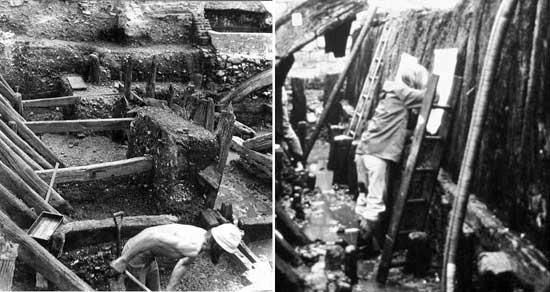 John generates spoil by the bucketful… while Cath Maloney records upstanding archaeology
John generates spoil by the bucketful… while Cath Maloney records upstanding archaeology
The huge amounts of spoil generated were then barrowed off site on long scaffold-boarded runways up a spectacularly terraced spoil heap, known affectionately as the Triggurat. Here, each barrowload was again spread out for finds recovery (at least one 14th century pilgrim souvenir was discovered in this way), as the mountain rose ever higher. Given that the spoil was peat-rich, archaeologists who had gardens or plant pots would take some home to help green the capital. The south-facing terraces of the edifice also proved perfect for growing sunflowers, tomatoes and other regular crops.
Winters on site were cold and the thermals ordered from Damart didn’t provide the warmth of fabrics and ski clothes yet to be invented. Even cold water seemed warm to very frozen hands. Extra warmth for the feet was provided by plastic finds bags worn over socks, even within the pointed-toe pink wellington boots Chrissie wore. The warmest coats available were the Afghans, another throwback to the previous decade, or donkey jackets discarded by labourers on City building sites. But all that was quickly forgotten in the long hot summer of 1974. Skimpy tops replaced the woolies and cut-down Levis replaced the flares. Plimsoles remained the preferred footwear, while the smell of Ambre Solaire hung heavy in the air. It was a hard life.
Come And Get It
Everybody on site knew what the time was as, like London’s ancient citizenry, they had the quarterly chimes of St Paul’s to remind them. Thus, when the chimes for tea-time stuck, a well-organised masterplan sprang into action. There being no tea-making facilities on site, the plan involved a rota and a journey to a local café, the Piccolo, to collect refreshments. This task required making a long list of names or initials, linked to T+ T- C+ C- plus sundry dainties (eg ratbag pie), SS (sausage sarnie) or KK (kitkat) Hard cash was crucial. Whoever undertook this vital mission was usually rewarded with a free tea on the house while the cheerful cooks prepared the victuals. As for lunch in those pre-Pret days, the Piccolo offered full English, white sliced bread and chips with everything and what tasty chips they were. Almost unbelievably in the modern keto and gluten-free era, the Piccolo is still there essentially offering a not dissimilar menu.
In the 1970s, there was a problem at weekends, when the excavations opened for work with the loyal Sunday volunteers: much of the City was totally closed, with few nearby cafes in operation. Luckily there was one emporium that kept its doors open, and this was Mick’s in nearby Fleet Street which, in addition to sandwiches, also served real meals (knives & forks). For those too stingy to order a full dinner, a spotted dick and hot custard would fill a cold winter stomach. Alas, Mick’s closed in the 1990s, and is now Crabthai, how times change…
We Can Work It Out
Medieval waterfront sites like Trig Lane are, to put it politely, quite different from most urban archaeological excavations.On inland sites, the ancient layers lie one on top of the other, with the oldest at the bottom of the sequence, perhaps at a depth up 1 or 2m below modern basement levels. The real challenge and key difference on riverside sites is that there have been several centuries of waterfront encroachment or reclamation over the river’s ancient foreshore.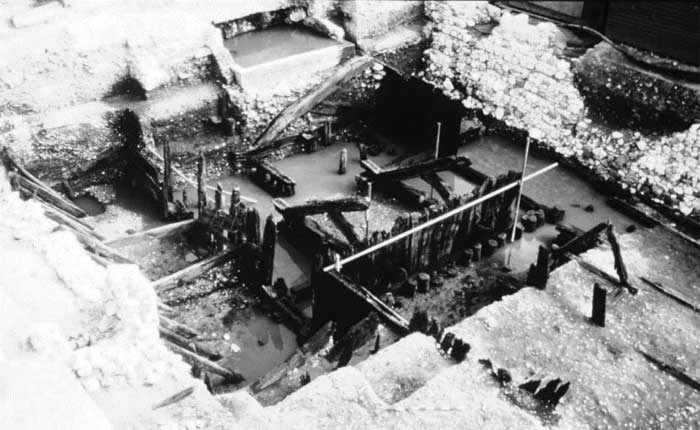 Trig Lane medieval waterfront development, from left to right:
Trig Lane medieval waterfront development, from left to right:
13th century revetment, mid 14th century, late 14th century then 15th century river wallThis means the original medieval waterfrontage lies to the north of the site against Thames Street, while the latest deposits lie lay not beneath them, but in front of them, to the south, up against the modern river wall. Thus a waterfront sequence, extending from the10th to the15th century, was not a mere 1m to 2m thick, but could be a staggering 100m long. That’s a lot of digging, especially as those reclamation dumps are deep and waterlogged, and interspersed with ridiculously well-preserved medieval timber revetement structures or masonry riverwalls.
Having recently completed a detailed section drawing showing such a typical sequence of 13th to 15th century timber and masonry-faced waterfront advances (see above) Chrissie thought today would be different. She decided to extend that sequence down onto the modern foreshore, relating the medieval encroachments to a modern context, in the form of the current Trig Stairs. Although not in the original excavation brief (no restrictive research agendas in this era) this was a clever and pioneering concept. So, armed with a large drawing board, several equally large gridded permatrace sheets, bulldog clips and a sharp 6H pencil, the ancient art of manual site survey extended the site sequence beyond the southern limit of the deep excavation, over the top of the 15th century river wall, up to the modern walkway, down Trig Stairs and over the Thames foreshore (the tide was out). This she achieved using two 30m tapes, string, masonry nails, line levels, plumb bob, hand tape, a dumpy level and a willing helper. Geomatics had to wait till the next century. All in a Day’s Artwork: Chrissie’s now iconic waterfront section drawing
All in a Day’s Artwork: Chrissie’s now iconic waterfront section drawing
Long And Winding
After a hard day’s digging, came the long walk home, longer in time, rather than miles. To break it up and provide some much needed sustenance, Chrissie and Gustav would often stop in Clerkenwell for tea and cake at the Aylesbury Café, in Jerusalem passage just past St John’s Gate. After that, it was uphill all the way. But the day’s labours needed to be mulled over, thoughts about tomorrow suggested and some gentle gossip exchanged. Like all return journeys, the view was different in this direction, the sun casting shadows on the opposite side of the street. But there was also an additional requirement, since they had to buy something for dinner from shops along the way. Not having a fridge meant that this was a daily necessity. Chrissie was a cook of some distinction, while Gustav relied more on fillings for toasted sandwiches, so the choice of shop varied depending on the proposed menus. Groceries duly purchased, their ways parted as they reached the Cally.
Once home Gustav had cats to feed. Washing took place in that bathless flat in a basin in the kitchen. Then there was toast to be toasted under a temperamental gas grill, while Radio 4 chatted brightly in the background. It was good to sit down and reflect. It hadn’t rained and, all told, it had been a good day. But then so was yesterday, while the plans for tomorrow were already looking good. As he explained to his cats, he liked what he did, because he did what he liked.
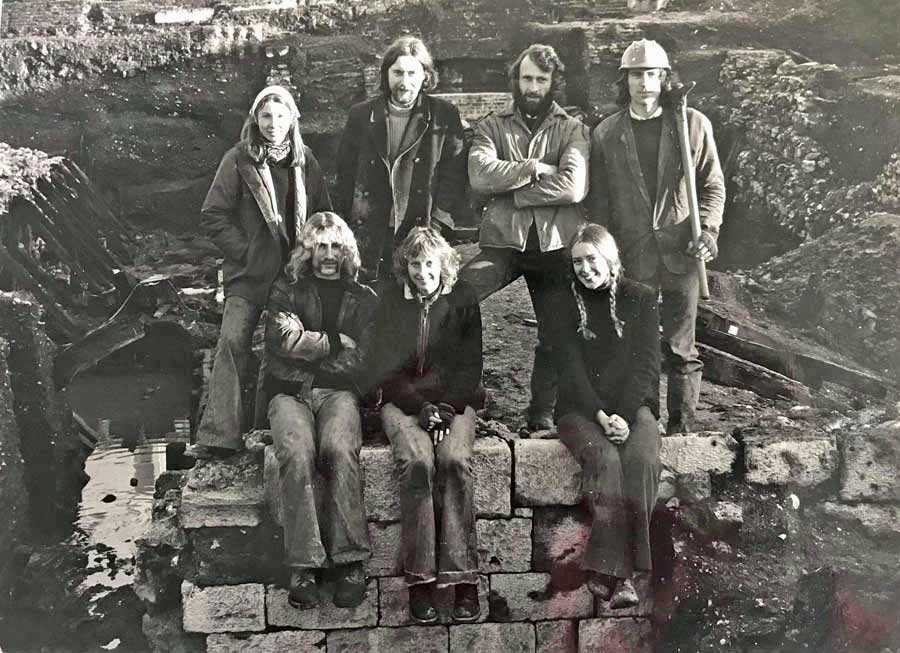 End of an Era: Last photo of the Trig Lane site in 1976
End of an Era: Last photo of the Trig Lane site in 1976
Back Row L-R: Katie Robinson, Geoff Egan RIP, Trevor Dennis, John Burke-Easton,
Front Row: Gustav Milne, Chrissie Milne (Harrison), Caroline Grace.
Photo taken by John Bailey
Acknowledgments: Trevor Dennis, Geoff Egan RIP, Peter Ellis, John Faulkner, Brian Gilmour, Caroline Grace, Charlotte Harding, Jackie Harrison, Mark Harrison, Lynne Keys, Amanda Makilwain, John & Cath Maloney, Gustav Milne, Chrissie Milne (Harrison), Jamie Muir, Jane Pouliblanc, Dick Robinson, Katie Robinson, Kieron Tyler, Val Turnbull RIP, Clare Wilkinson and many more.
The superb COLAS weekend team



Comments powered by CComment